Galerie virtuelle des oeuvres de Mme Vigée Le Brun
+16
Duc d'Ostrogothie
Marquis de Bombelles
Trianon
JAGdelile
CLIOXVIII
fleurdelys
Vicq d Azir
MARIE ANTOINETTE
La nuit, la neige
Lucius
Gouverneur Morris
Comtesse Diane
Mousseline
Comte d'Hézècques
Mr de Talaru
Mme de Sabran
20 participants
LE FORUM DE MARIE-ANTOINETTE :: La France et le Monde au XVIIIe siècle :: Les Arts et l'artisanat au XVIIIe siècle :: Les arts graphiques et la sculpture
Page 13 sur 15
Page 13 sur 15 •  1 ... 8 ... 12, 13, 14, 15
1 ... 8 ... 12, 13, 14, 15 
 Re: Galerie virtuelle des oeuvres de Mme Vigée Le Brun
Re: Galerie virtuelle des oeuvres de Mme Vigée Le Brun
Ouh ! Quel joli portrait... 
Sera présenté en vente aux enchères, le 5 juillet 2018, chez Christie's Londres :
Elisabeth-Louise Vigée Le Brun
Portrait of La maréchale-comtesse de Mailly, née Blanche Charlotte Marie Félicité de Narbonne Pelet (1761-1840)
Signed and dated 'Lse LeBrun.f.1783' (lower left)
oil on canvas, oval, 73.4 x 58.7 cm

Note au catalogue (extraits) :
Blanche Charlotte Marie Félicité de Narbonne- Pelet, maréchale-comtesse de Mailly (1761-1840), was the daughter of François Raymond Joseph Herménegilde Amalric, vicomte de Narbonne- Pelet and lieutenant-general in Louis XV’s army, and his second wife, Lucrèce Pauline Marie Anne de Ricard de Brégançon.
Blanche was married on 15 April 1780 in Saint-Germain-l’Auxerrois to Joseph Augustin, the comte de Mailly, marquis d’Harcourt (1708-1794), a member of the old nobility of Picardy ; she was 19 years old at the time of her wedding, and the third wife of her new husband, who was then in his 70s.
Despite the dramatic age difference, theirs, we are told, was a happy marriage.
Valued by Louis XVI, the marquis was entrusted with the expansion and modernisation of the port of Languedoc- Roussillon, the departure point for French vessels participating in the American War of Independence.
In 1783, the year in which the 22 year-old Blanche sat to Vigée Le Brun, her husband was promoted by the king to marshal of France.
(...)
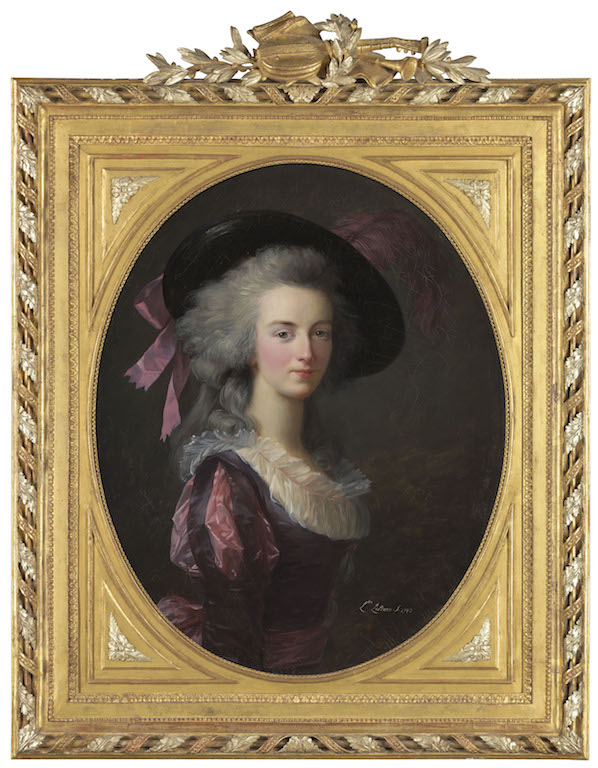
On 19 February 1792, Madame de Mailly gave birth to her only child, a son, Adrien Augustin Amalric (1792-1878). This happiness was soon overshadowed, however, by the swiftly unfolding events of the French Revolution, which were to overtake the family.
The maréchal de Mailly, who had been entrusted by Louis XVI with the defence of the Palais des Tuileries, was present on 10 August 1792, when the Paris mobs, members of the National Guard, and the Paris Commune stormed the palace, massacred the Swiss Guard, and initiated the fall of the monarchy.
At least one thousand participants were killed in the assault on the Tuileries ; Mailly and his family escaped and took refuge in the Château de Moreuil, in Picardy, but were arrested there on 7 September 1793.
The maréchal was guillotined in Arras on 23 March 1794, aged 85; at the time, the oldest man to have been put to death.

Madame de Mailly escaped her husband’s fate when she was freed from prison in July 1794, following the fall of Robespierre and the ending of The Terror.
Her husband’s wealth confiscated, she went into hiding in Paris, but managed to buy back the Château de la Roche de Vaux and, in 1797, reclaimed not only her husband’s unsold properties but also monies raised from the sales of confiscated property.
As the widow of a marshal of France, she received a pension of 6000 francs under the Empire. Subsequently, Madame de Mailly served in attendance at the Imperial court of Napoleon Bonaparte and sent her son Adrian, then 17 years old, to the École Militaire. In 1812, he fought in the Russian campaign and was wounded.
A peer of France, he remained loyal to the elder branch of the Bourbons after the 1830 Revolution and refused to swear an oath of loyalty to Louis Philippe I. He had the much-damaged Château de La Roche de Vaux rebuilt in the 1830s and renamed it La Roche-Mailly, dying there on 1 July 1878 (the castle survives, a Monument Historique in the Loire valley, and operates as a Bed and Breakfast).
His mother died, weeks short of her 80th birthday, on 15 January 1840.
 Source et infos complémentaires : Christie's Old Masters, Juillet 2018
Source et infos complémentaires : Christie's Old Masters, Juillet 2018

Sera présenté en vente aux enchères, le 5 juillet 2018, chez Christie's Londres :
Elisabeth-Louise Vigée Le Brun
Portrait of La maréchale-comtesse de Mailly, née Blanche Charlotte Marie Félicité de Narbonne Pelet (1761-1840)
Signed and dated 'Lse LeBrun.f.1783' (lower left)
oil on canvas, oval, 73.4 x 58.7 cm

Note au catalogue (extraits) :
Blanche Charlotte Marie Félicité de Narbonne- Pelet, maréchale-comtesse de Mailly (1761-1840), was the daughter of François Raymond Joseph Herménegilde Amalric, vicomte de Narbonne- Pelet and lieutenant-general in Louis XV’s army, and his second wife, Lucrèce Pauline Marie Anne de Ricard de Brégançon.
Blanche was married on 15 April 1780 in Saint-Germain-l’Auxerrois to Joseph Augustin, the comte de Mailly, marquis d’Harcourt (1708-1794), a member of the old nobility of Picardy ; she was 19 years old at the time of her wedding, and the third wife of her new husband, who was then in his 70s.

Despite the dramatic age difference, theirs, we are told, was a happy marriage.
Valued by Louis XVI, the marquis was entrusted with the expansion and modernisation of the port of Languedoc- Roussillon, the departure point for French vessels participating in the American War of Independence.
In 1783, the year in which the 22 year-old Blanche sat to Vigée Le Brun, her husband was promoted by the king to marshal of France.
(...)

On 19 February 1792, Madame de Mailly gave birth to her only child, a son, Adrien Augustin Amalric (1792-1878). This happiness was soon overshadowed, however, by the swiftly unfolding events of the French Revolution, which were to overtake the family.
The maréchal de Mailly, who had been entrusted by Louis XVI with the defence of the Palais des Tuileries, was present on 10 August 1792, when the Paris mobs, members of the National Guard, and the Paris Commune stormed the palace, massacred the Swiss Guard, and initiated the fall of the monarchy.
At least one thousand participants were killed in the assault on the Tuileries ; Mailly and his family escaped and took refuge in the Château de Moreuil, in Picardy, but were arrested there on 7 September 1793.
The maréchal was guillotined in Arras on 23 March 1794, aged 85; at the time, the oldest man to have been put to death.

Madame de Mailly escaped her husband’s fate when she was freed from prison in July 1794, following the fall of Robespierre and the ending of The Terror.
Her husband’s wealth confiscated, she went into hiding in Paris, but managed to buy back the Château de la Roche de Vaux and, in 1797, reclaimed not only her husband’s unsold properties but also monies raised from the sales of confiscated property.
As the widow of a marshal of France, she received a pension of 6000 francs under the Empire. Subsequently, Madame de Mailly served in attendance at the Imperial court of Napoleon Bonaparte and sent her son Adrian, then 17 years old, to the École Militaire. In 1812, he fought in the Russian campaign and was wounded.
A peer of France, he remained loyal to the elder branch of the Bourbons after the 1830 Revolution and refused to swear an oath of loyalty to Louis Philippe I. He had the much-damaged Château de La Roche de Vaux rebuilt in the 1830s and renamed it La Roche-Mailly, dying there on 1 July 1878 (the castle survives, a Monument Historique in the Loire valley, and operates as a Bed and Breakfast).
His mother died, weeks short of her 80th birthday, on 15 January 1840.
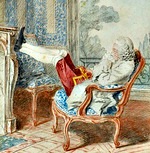
La nuit, la neige- Messages : 18132
Date d'inscription : 21/12/2013
 Re: Galerie virtuelle des oeuvres de Mme Vigée Le Brun
Re: Galerie virtuelle des oeuvres de Mme Vigée Le Brun
Très beau tableau.
Pauvre femme, mariée à un vieillard à l'âge de 19 ans ...
Pauvre femme, mariée à un vieillard à l'âge de 19 ans ...

Duc d'Ostrogothie- Messages : 3227
Date d'inscription : 04/11/2017
 Re: Galerie virtuelle des oeuvres de Mme Vigée Le Brun
Re: Galerie virtuelle des oeuvres de Mme Vigée Le Brun
Enorme différence d'âge, n'est-ce pas !  C'est comme moi !
C'est comme moi ! 
J'avais une tendresse quasi filiale pour mon mari et cela s'est très bien passé .
Le pauvret a quand même réussi à me faire deux enfants .
 C'est comme moi !
C'est comme moi ! 
J'avais une tendresse quasi filiale pour mon mari et cela s'est très bien passé .
Le pauvret a quand même réussi à me faire deux enfants .
_________________
... demain est un autre jour .

Mme de Sabran- Messages : 55497
Date d'inscription : 21/12/2013
Localisation : l'Ouest sauvage

Vicq d Azir- Messages : 3676
Date d'inscription : 07/11/2014
Age : 76
Localisation : Paris x
 Re: Galerie virtuelle des oeuvres de Mme Vigée Le Brun
Re: Galerie virtuelle des oeuvres de Mme Vigée Le Brun
Oui très beau vraiment !
Merci, cher Févicq.
Dans ses Mémoires, Mme Le Brun ne tarit pas de détails passionnants sur la Russie, la Cour et les palais de Catherine .
_________________
... demain est un autre jour .

Mme de Sabran- Messages : 55497
Date d'inscription : 21/12/2013
Localisation : l'Ouest sauvage
 Re: Galerie virtuelle des oeuvres de Mme Vigée Le Brun
Re: Galerie virtuelle des oeuvres de Mme Vigée Le Brun
Un portrait intéressant, prochainement présenté en vente aux enchères.
Tout d'abord, le sujet n'est pas une femme ; il est tardif dans la carrière de l'artiste ; et représente un homme qui fut une figure de l'Empire napoléonien (notamment proche de Lucien Bonaparte).
; il est tardif dans la carrière de l'artiste ; et représente un homme qui fut une figure de l'Empire napoléonien (notamment proche de Lucien Bonaparte).
Elisabeth Vigée Le Brun donne ici dans un classicisme simple, mais avec beaucoup de charme et l'élégance qui a fait son style...
Élisabeth-Louise Vigée Le Brun
Portrait of Jean Charles Sapey (1775-1857)
signed and dated 'L E Vigée / Le Brun 1819' (lower right)
oil on canvas, unlined (64.8 x 54 cm)
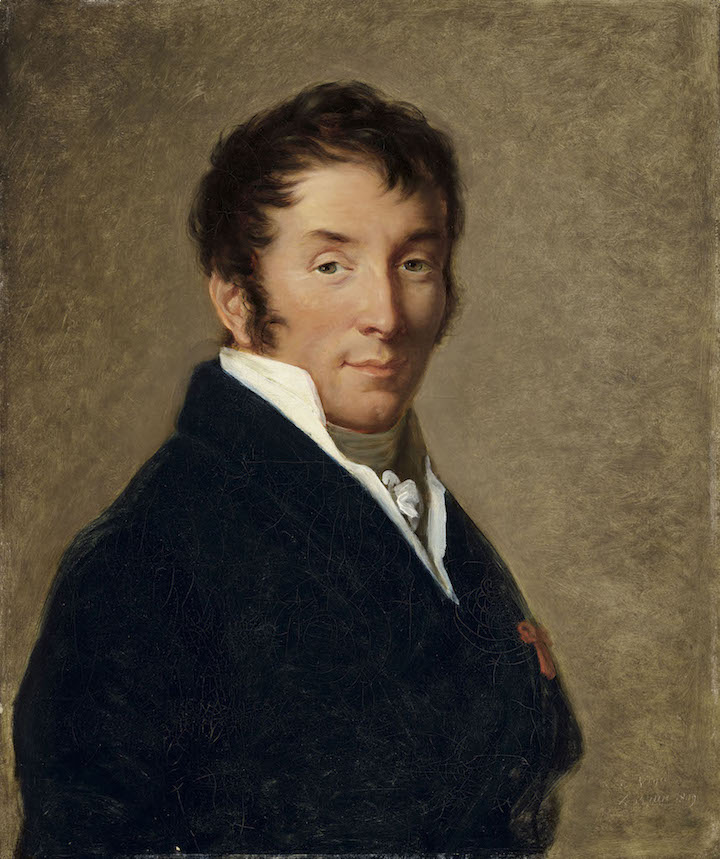
Photo : Christie's
Note au catalogue (extraits) :
Jean Charles Sapey, captured in this handsome portrait by Louise Vigée Le Brun during the Second Bourbon Restoration, served his country as a military officer, a civil administrator and a legislator.
(...)
Having completed his studies before the outbreak of the French Revolution – he was originally destined for the priesthood – Charles Sapey entered the military academy at Tournon.
He joined the 9th Battalion of Volunteers in the département of the Isère, a corps that was created in early April 1794 (Germinal an II) and was eventually integrated into the French armies serving under General Napoleon Bonaparte in the Alps, the kingdom of Naples and other parts of Italy.
In 1794 Sapey was put in charge of the company that controlled shipping between Continental Europe and the island of Corsica. He was also a major supplier of ships and munitions to the Armée du Midi and for a time worked with Christophe Salicetti, the Corsican ally of Robespierre in various places, including the port city of Livorno.
(...)
This activity brought him into close contact with the Bonapartes, especially Napoleon’s younger brother, Lucien – then such a radical Montagnard revolutionary allied with Robespierre and his acolytes that he styled himself ‘Brutus’ – and with the matriarch of the clan, Maria Laetizia Ramolino Buonaparte.
By the spring of 1799, Sapey was in Paris, where he leased the Château de Bagatelle, the beautiful little pleasure house built and embellished between 1777 and the mid-1780s near the Bois de Boulogne for Louis XVI’s sybaritic younger brother, the comte d’Artois and future Charles X.
(...)
Lucien was named Minister of the Interior, and Sapey remained at his side as one of his private secretaries.
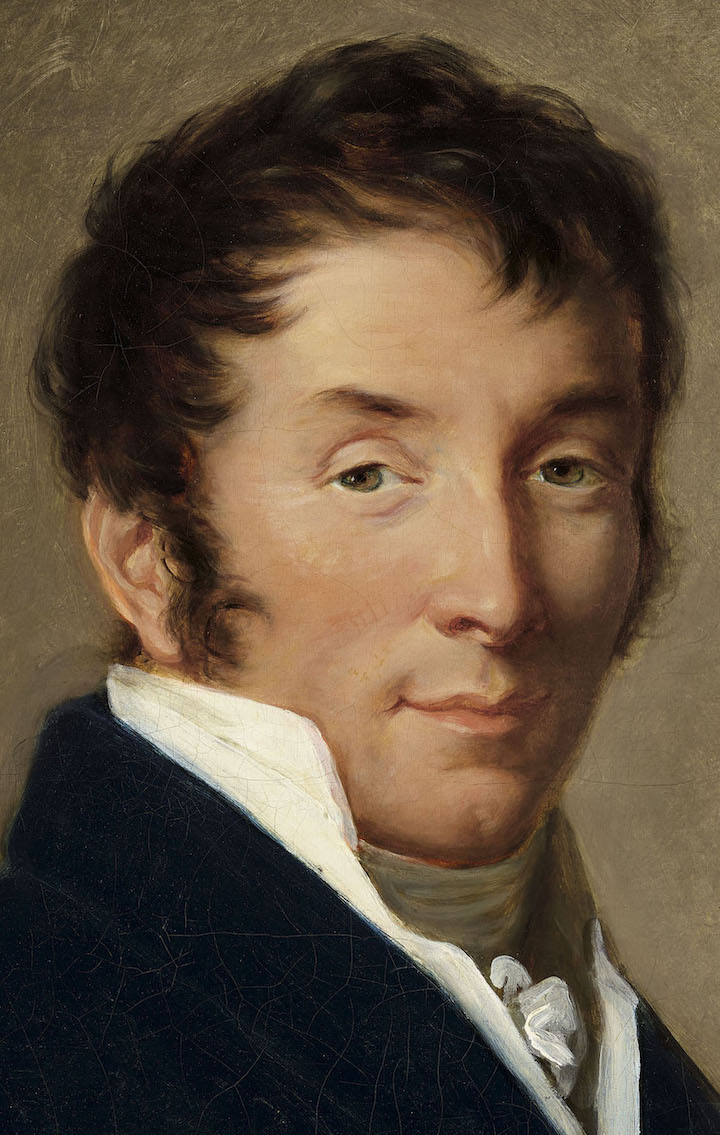
Photo : Christie's
In 1800, having violently quarreled with Joseph Fouché, his brother’s Minister of Police, Lucien was sent to Madrid as an ambassador with the mission of bringing the Spanish into line with France’s expansionist ambitions.
Sapey was posted there the following year as one of the secretaries of the French legation.
By 1804 the two were in Milan, where Sapey was asked to be godfather to Lucien’s daughter, Marie-Laetitia, with his second wife, Alexandrine de Bleschamp, widow of the banker Hippolyte Jouberthon.
(...)
Following the fall of the Napoleonic Empire and the inauguration of Louis XVIII, Charles Sapey remained steadfastly loyal to his friend, Lucien, pursuing a political career in the Chamber of Deputies, where for many years he sat with the liberal opposition.
The fall of the Empire took place to the great delight of the ultra-conservative Vigée Le Brun, who was a committed royalist.
This makes the commissioning of the present portrait rather perplexing. It may be explained by the fact that the artist had gotten along rather well with Lucien Bonaparte, himself an art aficionado (...)
* Source et infos complémentaires :
 Christie's N.Y : Auction Sale "Old Masters"
Christie's N.Y : Auction Sale "Old Masters"
Tout d'abord, le sujet n'est pas une femme
 ; il est tardif dans la carrière de l'artiste ; et représente un homme qui fut une figure de l'Empire napoléonien (notamment proche de Lucien Bonaparte).
; il est tardif dans la carrière de l'artiste ; et représente un homme qui fut une figure de l'Empire napoléonien (notamment proche de Lucien Bonaparte).Elisabeth Vigée Le Brun donne ici dans un classicisme simple, mais avec beaucoup de charme et l'élégance qui a fait son style...
Élisabeth-Louise Vigée Le Brun
Portrait of Jean Charles Sapey (1775-1857)
signed and dated 'L E Vigée / Le Brun 1819' (lower right)
oil on canvas, unlined (64.8 x 54 cm)

Photo : Christie's
Note au catalogue (extraits) :
Jean Charles Sapey, captured in this handsome portrait by Louise Vigée Le Brun during the Second Bourbon Restoration, served his country as a military officer, a civil administrator and a legislator.
(...)
Having completed his studies before the outbreak of the French Revolution – he was originally destined for the priesthood – Charles Sapey entered the military academy at Tournon.
He joined the 9th Battalion of Volunteers in the département of the Isère, a corps that was created in early April 1794 (Germinal an II) and was eventually integrated into the French armies serving under General Napoleon Bonaparte in the Alps, the kingdom of Naples and other parts of Italy.
In 1794 Sapey was put in charge of the company that controlled shipping between Continental Europe and the island of Corsica. He was also a major supplier of ships and munitions to the Armée du Midi and for a time worked with Christophe Salicetti, the Corsican ally of Robespierre in various places, including the port city of Livorno.
(...)
This activity brought him into close contact with the Bonapartes, especially Napoleon’s younger brother, Lucien – then such a radical Montagnard revolutionary allied with Robespierre and his acolytes that he styled himself ‘Brutus’ – and with the matriarch of the clan, Maria Laetizia Ramolino Buonaparte.
By the spring of 1799, Sapey was in Paris, where he leased the Château de Bagatelle, the beautiful little pleasure house built and embellished between 1777 and the mid-1780s near the Bois de Boulogne for Louis XVI’s sybaritic younger brother, the comte d’Artois and future Charles X.
(...)
Lucien was named Minister of the Interior, and Sapey remained at his side as one of his private secretaries.

Photo : Christie's
In 1800, having violently quarreled with Joseph Fouché, his brother’s Minister of Police, Lucien was sent to Madrid as an ambassador with the mission of bringing the Spanish into line with France’s expansionist ambitions.
Sapey was posted there the following year as one of the secretaries of the French legation.
By 1804 the two were in Milan, where Sapey was asked to be godfather to Lucien’s daughter, Marie-Laetitia, with his second wife, Alexandrine de Bleschamp, widow of the banker Hippolyte Jouberthon.
(...)
Following the fall of the Napoleonic Empire and the inauguration of Louis XVIII, Charles Sapey remained steadfastly loyal to his friend, Lucien, pursuing a political career in the Chamber of Deputies, where for many years he sat with the liberal opposition.
The fall of the Empire took place to the great delight of the ultra-conservative Vigée Le Brun, who was a committed royalist.
This makes the commissioning of the present portrait rather perplexing. It may be explained by the fact that the artist had gotten along rather well with Lucien Bonaparte, himself an art aficionado (...)
* Source et infos complémentaires :

La nuit, la neige- Messages : 18132
Date d'inscription : 21/12/2013
 Re: Galerie virtuelle des oeuvres de Mme Vigée Le Brun
Re: Galerie virtuelle des oeuvres de Mme Vigée Le Brun
Ce monsieur a un air d'avoir deux airs , mais le portrait est très beau !

_________________
... demain est un autre jour .

Mme de Sabran- Messages : 55497
Date d'inscription : 21/12/2013
Localisation : l'Ouest sauvage
 Re: Galerie virtuelle des oeuvres de Mme Vigée Le Brun
Re: Galerie virtuelle des oeuvres de Mme Vigée Le Brun
Deux airs ?... C'est vrai que c'est un beau portrait, qui sort de l'iconographie traditionnelle d'EVL.

Duc d'Ostrogothie- Messages : 3227
Date d'inscription : 04/11/2017
 Re: Galerie virtuelle des oeuvres de Mme Vigée Le Brun
Re: Galerie virtuelle des oeuvres de Mme Vigée Le Brun
Tu le ferais confiance, toi, avec cet air chafoin ?

_________________
... demain est un autre jour .

Mme de Sabran- Messages : 55497
Date d'inscription : 21/12/2013
Localisation : l'Ouest sauvage
 Re: Galerie virtuelle des oeuvres de Mme Vigée Le Brun
Re: Galerie virtuelle des oeuvres de Mme Vigée Le Brun
Non pas vraiment .  Il a les yeux de Danièle Evenou après son lifting.
Il a les yeux de Danièle Evenou après son lifting. 
https://www.tf1.fr/tf1/action-ou-verite/videos/daniele-evenou-chirurgie-esthetique.html

https://www.tf1.fr/tf1/action-ou-verite/videos/daniele-evenou-chirurgie-esthetique.html

Duc d'Ostrogothie- Messages : 3227
Date d'inscription : 04/11/2017
 Re: Galerie virtuelle des oeuvres de Mme Vigée Le Brun
Re: Galerie virtuelle des oeuvres de Mme Vigée Le Brun
C'est selon . Pauvre Danièle !

Cela dit, je trouve Mme Le Brun plus " intéressante " lorsque, comme dans ce portrait-ci, elle ne donne pas un air éternellement évanescent et angélique à ses modèles ( hommes et femmes confondus d'ailleurs ) .
Avoir su capter cette expression un poil sournoise prouve son talent .
_________________
... demain est un autre jour .

Mme de Sabran- Messages : 55497
Date d'inscription : 21/12/2013
Localisation : l'Ouest sauvage
 Re: Galerie virtuelle des oeuvres de Mme Vigée Le Brun
Re: Galerie virtuelle des oeuvres de Mme Vigée Le Brun
Le sourcil droit relevé et le jeu d'ombre sur la bouche lui donnent un air légèrement suffisant.
Mais en même temps, il n'a pas l'air méchant. En tout cas, c'est un portrait vivant, qui révèle effectivement le grand talent d'EVL. Le portrait de la comtesse de Mailly posté en haut de la page est l'un des plus stupéfiants je trouve : elle a l'air à la fois belle et bonne. Un bouquet de roses que cette comtesse de Mailly.
Mais en même temps, il n'a pas l'air méchant. En tout cas, c'est un portrait vivant, qui révèle effectivement le grand talent d'EVL. Le portrait de la comtesse de Mailly posté en haut de la page est l'un des plus stupéfiants je trouve : elle a l'air à la fois belle et bonne. Un bouquet de roses que cette comtesse de Mailly.


Duc d'Ostrogothie- Messages : 3227
Date d'inscription : 04/11/2017
 Re: Galerie virtuelle des oeuvres de Mme Vigée Le Brun
Re: Galerie virtuelle des oeuvres de Mme Vigée Le Brun
Duc d'Ostrogothie a écrit: elle a l'air à la fois belle et bonne
Belle et bonne, c'est ainsi que Voltaire appelait la marquise de la Villette .
Oui, Mme de Mailly semble tout cela, et très sage .
_________________
... demain est un autre jour .

Mme de Sabran- Messages : 55497
Date d'inscription : 21/12/2013
Localisation : l'Ouest sauvage
 Re: Galerie virtuelle des oeuvres de Mme Vigée Le Brun
Re: Galerie virtuelle des oeuvres de Mme Vigée Le Brun
Cueilli, à 19 ans, par un époux qui avait 51 ans de plus qu'elle...Duc d'Ostrogothie a écrit: Un bouquet de roses que cette comtesse de Mailly.


Dernière édition par La nuit, la neige le Dim 14 Oct 2018, 11:04, édité 1 fois

La nuit, la neige- Messages : 18132
Date d'inscription : 21/12/2013
 Re: Galerie virtuelle des oeuvres de Mme Vigée Le Brun
Re: Galerie virtuelle des oeuvres de Mme Vigée Le Brun
C'est comme feu mon époux : 50 ans de différence entre M. de Sabran et moi ...

Bigre, ça chiffre !!!
_________________
... demain est un autre jour .

Mme de Sabran- Messages : 55497
Date d'inscription : 21/12/2013
Localisation : l'Ouest sauvage
 Re: Galerie virtuelle des oeuvres de Mme Vigée Le Brun
Re: Galerie virtuelle des oeuvres de Mme Vigée Le Brun
La nuit, la neige a écrit:Cueilli, à 19 ans, par un époux qui avait 51 ans de plus qu'elle...Duc d'Ostrogothie a écrit: Un bouquet de roses que cette comtesse de Mailly.
La belle et la bête.


Duc d'Ostrogothie- Messages : 3227
Date d'inscription : 04/11/2017
 Re: Galerie virtuelle des oeuvres de Mme Vigée Le Brun
Re: Galerie virtuelle des oeuvres de Mme Vigée Le Brun
Présenté en vente aux enchères, par Sotheby's New York, le 30 janvier 2019...
Elisabeth-Louise Vigée Le Brun
PORTRAIT OF MRS. SPENCER PERCEVAL, NÉE JANE WILSON (1769-1844)
Signed and dated lower right: LeBrun / 1804
pastel on paper / 19 by 14 3/4 in.; 48 by 37.5 cm

Photo : Sotheby's
Note au catalogue (extraits) :
This elegant pastel portrait of the Irish aristocrat Lady Spencer Perceval is a mature work by the artist, completed during her time in England in 1803-5.
(...)
Dated 1804, the present pastel was executed while Vigée was living in London.
The high society and nobility in London received the artist warmly; indeed she wrote in her memoir that :
“Je retrouvai en Angleterre une grande quantité de compatriotes que je connaissais depuis longtemps … dans une réunion chez lady Parceval, qui recevait beaucoup d’émigrés”
E.L.Vigée-Lebrun, Souvenirs
Born Jane Wilson, daughter of Lieutenant General Sir Thomas Spencer Wilson, Lady Parceval married Spencer Perceval, younger son of the Earl of Egmont, in 1792. Though at the time his career as lawyer was unpromising (enough so that Sir Thomas disapproved of the marriage and the couple eloped), he soon experienced a rapid rise to power and in October 1809 became Prime Minister of England.

Jane and Spencer Perceval had thirteen children, of whom twelve survived. When this pastel was made in 1804, Lady Perceval was pregnant with her 11th child and Spencer Perceval was a leading politician in the conservative Pitt administration, which supported the old regime in France. Hence it comes as no surprise that Lady Perceval was closely acquainted with Vigée.
Given the kind mention in her memoir, their friendship must have been important to the artist, who mostly painted émigrés rather than British sitters while she was in England.
* Source et infos complémentaires : Sotheby's - Master Paintings Evening Sale
 Les experts Sotheby's précise, au sujet de la provenance de ce pastel : Collection Joseph-Hyacinthe-François-de-Paule de Rigaud, comte de Vaudreuil.
Les experts Sotheby's précise, au sujet de la provenance de ce pastel : Collection Joseph-Hyacinthe-François-de-Paule de Rigaud, comte de Vaudreuil.
Voir nos messages concernant sa collection d'oeuvres d'art ici :
 Le comte de Vaudreuil
Le comte de Vaudreuil
Elisabeth-Louise Vigée Le Brun
PORTRAIT OF MRS. SPENCER PERCEVAL, NÉE JANE WILSON (1769-1844)
Signed and dated lower right: LeBrun / 1804
pastel on paper / 19 by 14 3/4 in.; 48 by 37.5 cm

Photo : Sotheby's
Note au catalogue (extraits) :
This elegant pastel portrait of the Irish aristocrat Lady Spencer Perceval is a mature work by the artist, completed during her time in England in 1803-5.
(...)
Dated 1804, the present pastel was executed while Vigée was living in London.
The high society and nobility in London received the artist warmly; indeed she wrote in her memoir that :
“Je retrouvai en Angleterre une grande quantité de compatriotes que je connaissais depuis longtemps … dans une réunion chez lady Parceval, qui recevait beaucoup d’émigrés”
E.L.Vigée-Lebrun, Souvenirs
Born Jane Wilson, daughter of Lieutenant General Sir Thomas Spencer Wilson, Lady Parceval married Spencer Perceval, younger son of the Earl of Egmont, in 1792. Though at the time his career as lawyer was unpromising (enough so that Sir Thomas disapproved of the marriage and the couple eloped), he soon experienced a rapid rise to power and in October 1809 became Prime Minister of England.

Jane and Spencer Perceval had thirteen children, of whom twelve survived. When this pastel was made in 1804, Lady Perceval was pregnant with her 11th child and Spencer Perceval was a leading politician in the conservative Pitt administration, which supported the old regime in France. Hence it comes as no surprise that Lady Perceval was closely acquainted with Vigée.
Given the kind mention in her memoir, their friendship must have been important to the artist, who mostly painted émigrés rather than British sitters while she was in England.
* Source et infos complémentaires : Sotheby's - Master Paintings Evening Sale
______________________
Voir nos messages concernant sa collection d'oeuvres d'art ici :

La nuit, la neige- Messages : 18132
Date d'inscription : 21/12/2013
 Mme Baudin, par Elisabeth Vigée Le Brun
Mme Baudin, par Elisabeth Vigée Le Brun
Un joli portrait, que nous n'avions pas encore présenté dans cette galerie, mais qui me surprend un peu...
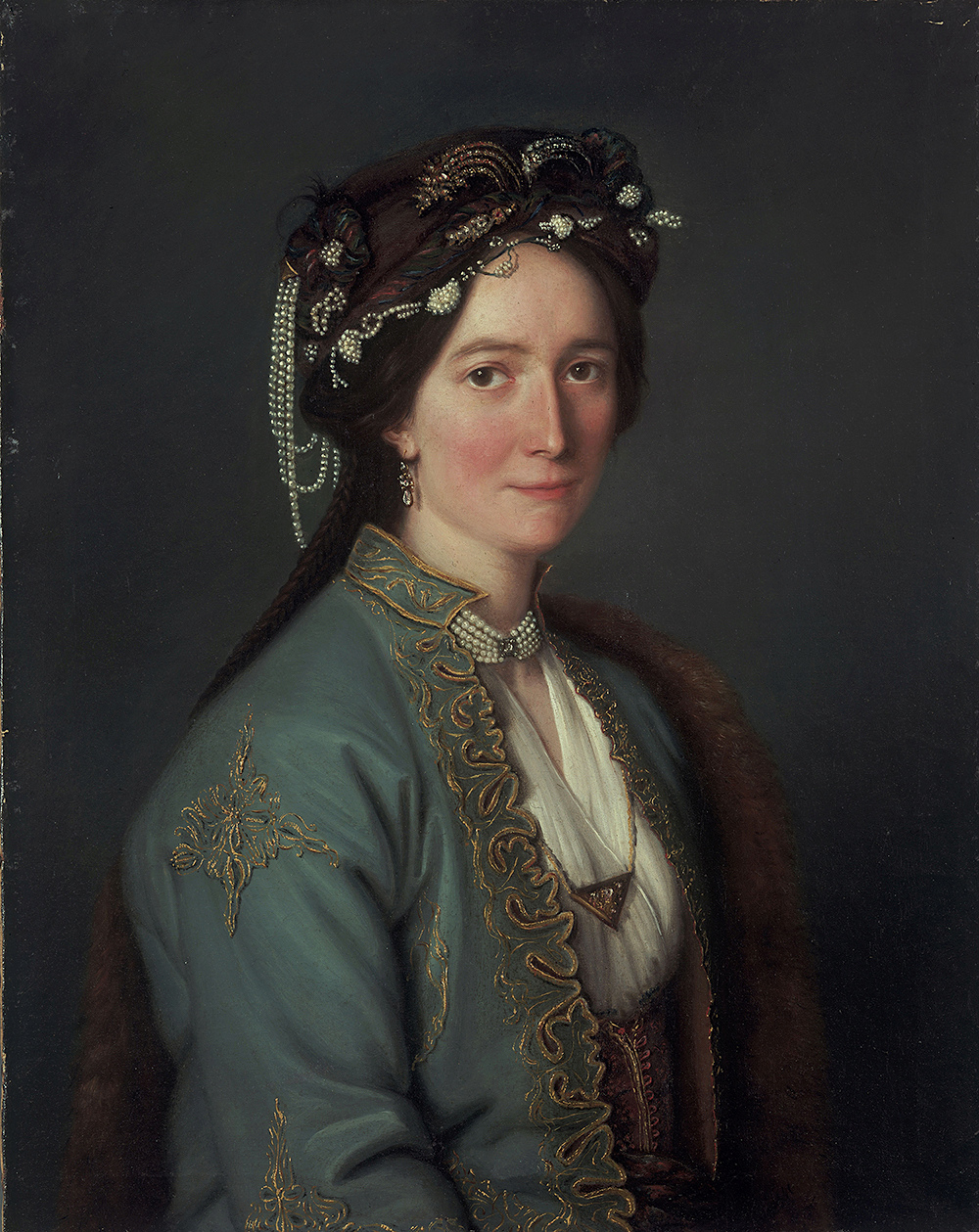
Portrait de Madame Baudin
Elisabeth Vigée Le Brun
Huile sur toile, vers 1835
Munich, Neue Bayrische Staatsgemäldesammlungen
Photo : BPK, Berlin, Dist. RMN / image BStGS
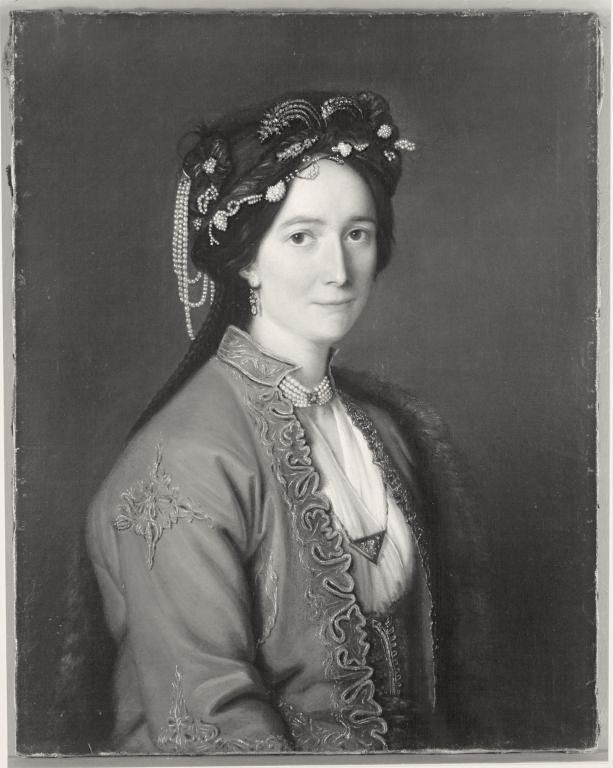
Photo : Bayrische Staatsgemäldesammlungen

Portrait de Madame Baudin
Elisabeth Vigée Le Brun
Huile sur toile, vers 1835
Munich, Neue Bayrische Staatsgemäldesammlungen
Photo : BPK, Berlin, Dist. RMN / image BStGS

Photo : Bayrische Staatsgemäldesammlungen
Dernière édition par La nuit, la neige le Ven 18 Jan 2019, 11:01, édité 2 fois

La nuit, la neige- Messages : 18132
Date d'inscription : 21/12/2013
 Re: Galerie virtuelle des oeuvres de Mme Vigée Le Brun
Re: Galerie virtuelle des oeuvres de Mme Vigée Le Brun
Oui, beau tableau, mais moi aussi il y a quelque chose qui me surprend. Le style vestimentaire, les nombreux bijoux dans les cheveux ? On se demande si cette femme ne vient pas d'un pays d'Europe de l'Est car ses habits ne correspondent pas du tout à la mode du 19ème siècle, en tout cas en France. Il me semble que c'est la première fois que je vois ce style. Mais, pourquoi pas !!!!!

Trianon- Messages : 3305
Date d'inscription : 22/12/2013
 Re: Galerie virtuelle des oeuvres de Mme Vigée Le Brun
Re: Galerie virtuelle des oeuvres de Mme Vigée Le Brun
Oui, ce portrait est intriguant. 
On ne peut pas dire que nous reconnaissons le pinceau de Mme Le Brun au premier coup d'oeil.
Je ne suis pas spécialiste, mais enfin il me paraît très très (trop) abouti pour une oeuvre des dernières années de vie de Mme Le Brun, puisque l'institution qui le conserve le date "vers 1835".
Vues à l'exposition du Grand Palais, le souvenir que j'ai des dernières oeuvres de l'artiste (qui n'a plus ni la vue, ni le doigté de sa jeunesse) sont assez loin de ce "réalisme détaillé" ; et encore étaient-elles datées des années 1820 !!
Aussi, sauf erreur de ma part, ce portrait n'est pas mentionné dans "l'inventaire" qu'elle a publié au moment de la rédaction de ses Souvenirs.
Enfin, j'ignore qui est cette Mme Baudin ?
Et nous aurions besoin de nos amis spécialistes de l'histoire des costumes pour nous aider à déterminer quelle pourrait être sa localisation géographique ?
On ne peut pas dire que nous reconnaissons le pinceau de Mme Le Brun au premier coup d'oeil.
Je ne suis pas spécialiste, mais enfin il me paraît très très (trop) abouti pour une oeuvre des dernières années de vie de Mme Le Brun, puisque l'institution qui le conserve le date "vers 1835".

Vues à l'exposition du Grand Palais, le souvenir que j'ai des dernières oeuvres de l'artiste (qui n'a plus ni la vue, ni le doigté de sa jeunesse) sont assez loin de ce "réalisme détaillé" ; et encore étaient-elles datées des années 1820 !!
Aussi, sauf erreur de ma part, ce portrait n'est pas mentionné dans "l'inventaire" qu'elle a publié au moment de la rédaction de ses Souvenirs.
Enfin, j'ignore qui est cette Mme Baudin ?
Et nous aurions besoin de nos amis spécialistes de l'histoire des costumes pour nous aider à déterminer quelle pourrait être sa localisation géographique ?

La nuit, la neige- Messages : 18132
Date d'inscription : 21/12/2013
 Re: Galerie virtuelle des oeuvres de Mme Vigée Le Brun
Re: Galerie virtuelle des oeuvres de Mme Vigée Le Brun
La nuit, la neige a écrit:
Enfin, j'ignore qui est cette Mme Baudin ?
Je suis allée farfouiller un peu du côté de Google qui sèche ...
_________________
... demain est un autre jour .

Mme de Sabran- Messages : 55497
Date d'inscription : 21/12/2013
Localisation : l'Ouest sauvage
 Re: Galerie virtuelle des oeuvres de Mme Vigée Le Brun
Re: Galerie virtuelle des oeuvres de Mme Vigée Le Brun
Je l'ai fait aussi, mais en préférant éventuellement retrouver...l'époux ! 
Il y a bien un Nicolas Baudin, marin, explorateur, cartographe français.
A la fin du XVIIIe siècle, il fit deux voyages scientifiques en Inde, puis sous le Directoire aux Antilles.
Enfin, en 1800, Napoléon le nomme à la tête d'une expédition destinée à l'exploration de la Nouvelle-Hollande (Australie).
Mais si ce portrait date bien des années 1830, les dates ne collent pas.
Il est né en 1750, et meurt en 1803, à l'Île Maurice, sur le retour de son voyage dans les terres australes.
Voir ici : https://fr.wikipedia.org/wiki/Nicolas_Baudin
Du reste, le costume de cette dame me paraît plus "slave qu'indien", non ?
Mais enfin bon, s'ils nous lisent, j'attends donc les commentaires de nos spécialistes et historiens des costumes.

Il y a bien un Nicolas Baudin, marin, explorateur, cartographe français.
A la fin du XVIIIe siècle, il fit deux voyages scientifiques en Inde, puis sous le Directoire aux Antilles.
Enfin, en 1800, Napoléon le nomme à la tête d'une expédition destinée à l'exploration de la Nouvelle-Hollande (Australie).
Mais si ce portrait date bien des années 1830, les dates ne collent pas.
Il est né en 1750, et meurt en 1803, à l'Île Maurice, sur le retour de son voyage dans les terres australes.
Voir ici : https://fr.wikipedia.org/wiki/Nicolas_Baudin
Du reste, le costume de cette dame me paraît plus "slave qu'indien", non ?
Mais enfin bon, s'ils nous lisent, j'attends donc les commentaires de nos spécialistes et historiens des costumes.


La nuit, la neige- Messages : 18132
Date d'inscription : 21/12/2013
 Re: Galerie virtuelle des oeuvres de Mme Vigée Le Brun
Re: Galerie virtuelle des oeuvres de Mme Vigée Le Brun
La nuit, la neige a écrit:
Du reste, le costume de cette dame me paraît plus "slave qu'indien", non ?
Si fait !
Merci pour ta recherche .
_________________
... demain est un autre jour .

Mme de Sabran- Messages : 55497
Date d'inscription : 21/12/2013
Localisation : l'Ouest sauvage

La nuit, la neige- Messages : 18132
Date d'inscription : 21/12/2013
 Re: Galerie virtuelle des oeuvres de Mme Vigée Le Brun
Re: Galerie virtuelle des oeuvres de Mme Vigée Le Brun
Oui, sauf que cette Madame Baudin est européenne.
Fichtre, cette orientale a au moins 3 kilos de vêtements sur elle. Elle avait peut-être froid.
Mais, c'est charmant.
Fichtre, cette orientale a au moins 3 kilos de vêtements sur elle. Elle avait peut-être froid.

Mais, c'est charmant.

Trianon- Messages : 3305
Date d'inscription : 22/12/2013
Page 13 sur 15 •  1 ... 8 ... 12, 13, 14, 15
1 ... 8 ... 12, 13, 14, 15 
 Sujets similaires
Sujets similaires» Etienne Vigée, le frère d'Elisabeth Vigée Le Brun
» Les autoportraits de Mme Vigée Le Brun
» Signature d'Elisabeth Vigée Le Brun
» Docu-fiction : Le fabuleux destin d'Elisabeth Vigee Le Brun, peintre de Marie-Antoinette (2015)
» Portraits de la duchesse de Polignac
» Les autoportraits de Mme Vigée Le Brun
» Signature d'Elisabeth Vigée Le Brun
» Docu-fiction : Le fabuleux destin d'Elisabeth Vigee Le Brun, peintre de Marie-Antoinette (2015)
» Portraits de la duchesse de Polignac
LE FORUM DE MARIE-ANTOINETTE :: La France et le Monde au XVIIIe siècle :: Les Arts et l'artisanat au XVIIIe siècle :: Les arts graphiques et la sculpture
Page 13 sur 15
Permission de ce forum:
Vous ne pouvez pas répondre aux sujets dans ce forum





